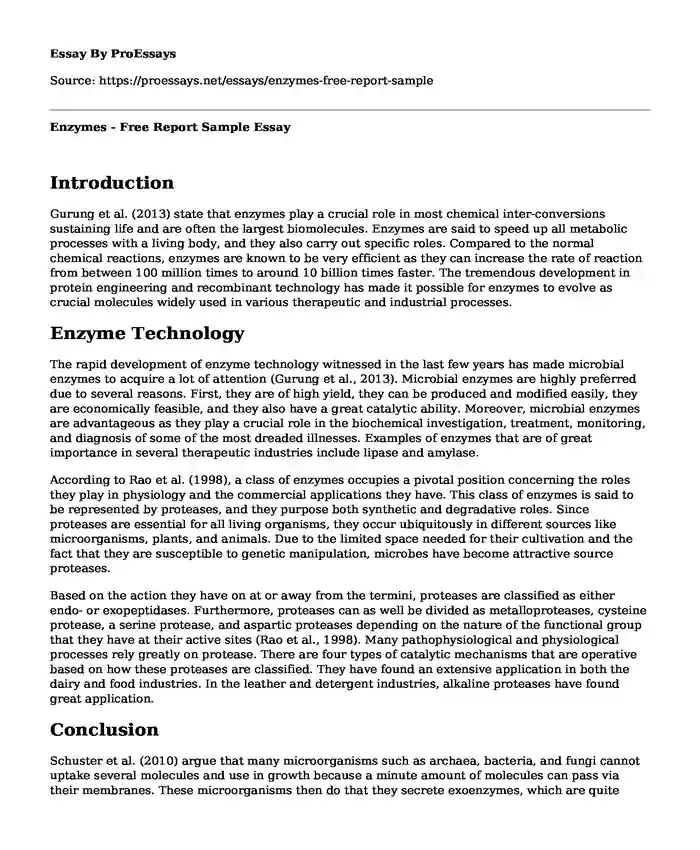Introduction
Gurung et al. (2013) state that enzymes play a crucial role in most chemical inter-conversions sustaining life and are often the largest biomolecules. Enzymes are said to speed up all metabolic processes with a living body, and they also carry out specific roles. Compared to the normal chemical reactions, enzymes are known to be very efficient as they can increase the rate of reaction from between 100 million times to around 10 billion times faster. The tremendous development in protein engineering and recombinant technology has made it possible for enzymes to evolve as crucial molecules widely used in various therapeutic and industrial processes.
Enzyme Technology
The rapid development of enzyme technology witnessed in the last few years has made microbial enzymes to acquire a lot of attention (Gurung et al., 2013). Microbial enzymes are highly preferred due to several reasons. First, they are of high yield, they can be produced and modified easily, they are economically feasible, and they also have a great catalytic ability. Moreover, microbial enzymes are advantageous as they play a crucial role in the biochemical investigation, treatment, monitoring, and diagnosis of some of the most dreaded illnesses. Examples of enzymes that are of great importance in several therapeutic industries include lipase and amylase.
According to Rao et al. (1998), a class of enzymes occupies a pivotal position concerning the roles they play in physiology and the commercial applications they have. This class of enzymes is said to be represented by proteases, and they purpose both synthetic and degradative roles. Since proteases are essential for all living organisms, they occur ubiquitously in different sources like microorganisms, plants, and animals. Due to the limited space needed for their cultivation and the fact that they are susceptible to genetic manipulation, microbes have become attractive source proteases.
Based on the action they have on at or away from the termini, proteases are classified as either endo- or exopeptidases. Furthermore, proteases can as well be divided as metalloproteases, cysteine protease, a serine protease, and aspartic proteases depending on the nature of the functional group that they have at their active sites (Rao et al., 1998). Many pathophysiological and physiological processes rely greatly on protease. There are four types of catalytic mechanisms that are operative based on how these proteases are classified. They have found an extensive application in both the dairy and food industries. In the leather and detergent industries, alkaline proteases have found great application.
Conclusion
Schuster et al. (2010) argue that many microorganisms such as archaea, bacteria, and fungi cannot uptake several molecules and use in growth because a minute amount of molecules can pass via their membranes. These microorganisms then do that they secrete exoenzymes, which are quite active when outside the cells. The exoenzymes can hence breakdown several molecules, making them easy to ingest. This engineering of microorganisms enabling them to produce different exoenzymes has attracted a lot of interest. "cheater" mutants often minimize these exoenzymes' productivity. Some of the most common exoenzymes include; lipases, ligninases, proteases, chitinases, cellulases, mannases, proteases, xylanases, amylases, and pectinases. All these exoenzymes are essential to maintaining the biosphere. When it comes to biotechnology, exoenzymes have a wide application since most industrial processes require the degradative property of exoenzymes.
Reference
Schuster, S., Kreft, J., Brenner, N., Wessely, F., Theißen, G., Ruppin, E., & Schroeter, A. (2010). Cooperation and cheating in microbial exoenzyme production - Theoretical analysis for biotechnological applications. Biotechnology Journal, 5(7), 751-758.
https://doi.org/10.1002/biot.200900303
Rao, M., Tanksale, A., Ghatge, M., & Deshpande, V. (1998). Molecular and Biotechnological Aspects of Microbial Proteases. Microbiology And Molecular Biology Reviews, 62(3), 597-635.
https://doi.org/10.1128/mmbr.62.3.597-635.1998
Gurung, N., Ray, S., Bose, S., & Rai, V. (2013). A Broader View: Microbial Enzymes and Their Relevance in Industries, Medicine, and Beyond. Biomed Research International, 2013, 1-18.
https://doi.org/10.1155/2013/329121.
Cite this page
Enzymes - Free Report Sample . (2023, Nov 25). Retrieved from https://proessays.net/essays/enzymes-free-report-sample
If you are the original author of this essay and no longer wish to have it published on the ProEssays website, please click below to request its removal:
- Essay Sample on Anatomic Planes in the Body of a Human Being
- Ultraviolet Radiation and Marine Photosynthesis Essay
- Research Paper on Uniting to Thwart the Worldwide Extinction Crisis
- Essay Example on Frederick's Transformation: Horizontal Gene Transfer & Pneumonia
- Essay Example on Science: Making the World a Better Place
- Free Essay Example on Glacier Bivachny: A Flowing Glacier in Central Pamir
- Protecting Endangered Species - Essay Sample







